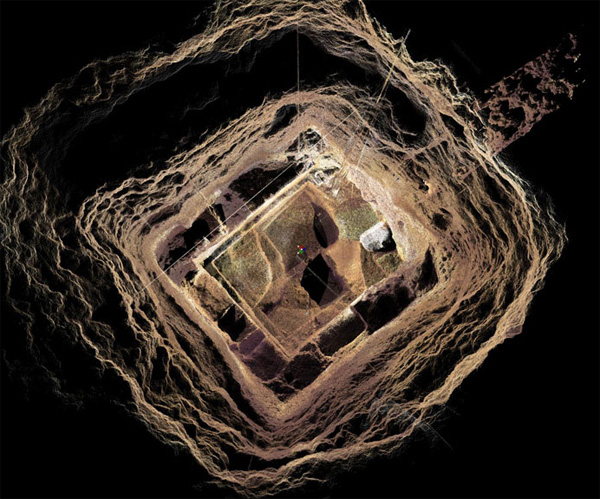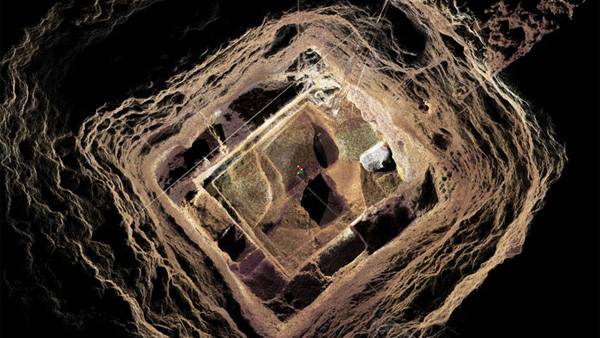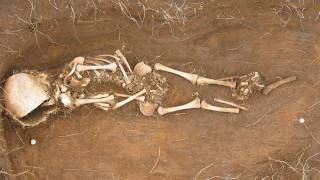Archaeologists Find Tunnel Below the Temple of the Feathered Serpent in Teotihuacan
Source: artdaily.org

Contextual image of the tunnel found in front of the Temple of the Feathered Serpent. Photo: CNMH INAH.
After eight months of excavation, archaeologists from the National Institute of Anthropology and History (INAH) have located, 12 meters below , the entrance to the tunnel leading to a series of galleries beneath the Temple of the Feathered Serpent, in the Archaeologcial Area of Teotihuacan, where the remains of rulers of the ancient city could have been deposited.
In a tour made by to site today with the media, archaeologist Sergio Chavez Gomez, director of the Tlalocan Project went below the ground and announced the advances in the systematic exploration undertaken by the INAH of the underground conduit, which was closed for about 1,800 years by the inhabitants of Teotihuacan themselves and where no one has gone in since then.
INAH specialists hope to enter the tunnel in a couple of months and will be the first to enter after hundreds of years since it was closed. This excavation, which represents the most profound that has been done in the pre-Hispanic site, is part of the commemorations for the first 100 years of uninterrupted archaeological explorations (made in 1910) also called the City of Gods.
Gómez Chávez explained that the tunnel passes under the Temple of the Feathered Serpent, the most important building of the Citadel, "and the entry was located a few meters from the pyramid.
Access is by a vertical shaft of about five meters per side down to a depth of 14 meters from the surface, the entrance leads into a long corridor with an estimated length of 100 meters which ends in a series of underground chambers excavated in the rock.
The tunnel was discovered in late 2003 by Sergio Gomez and Julie Gazzola, but its exploration has required several years of planning and managing the financial resources necessary to carry out research at the highest scientific level. The team is composed of more than 30 people and has advisors renowned nationally and internationally.
Before starting the excavations, the archaeologists from INAH had the collaboration of Dr. Victor Manuel Velasco, from the Institute of Geophysics of the UNAM, through a the use of a GPR it was determined that the tunnel has a length of about 100 meters, and has large chambers inside.
Another of the technologies used in the exploration has been the laser scanner, a sophisticated device with high resolution, facilitated by the National Coordination of Historical Monuments (CNMH). INAH made the three-dimensional record of the archaeological finds.
Just a couple of weeks ago, archaeologists corroborated that the tunnel entrance was located in the place they had anticipated, then opened a small hollow hole at the top of the access, and using the scanner took the first images from inside the tunnel to a length of 37 meters, of the 100 it is estimated to have in length.
"Although we need to excavate two more meters to reach the floor of the tunnel, having the first images of the inside will allow us to better plan how to enter. Even so, we will have to withdraw a large amount of soil and a heavy block of stone that blocks the access.
"The whole process could take two more months of work, as we continue with the same systematic exploration that we have done from the start to avoid losing important information that lets us know what activities the citizens of Teotihuacan performed thousands of years ago and why they decided to close it, "said archaeologist Sergio Gomez.
So far, 200 tons of earth have been withdrawn, he said, while doing this we have found about 60,000 pieces of artifacts and pottery.
Angel Mora, who belongs to the Technology Support Unit of the CNMH, and engineer Juan Carlos Garcia, who operates the scanner, said that by introducing the laser, which has a range of 300 meters, through the small hollow opening the archaeologists made, there was only a length of 37 meters. Mora noted that this reading is because the laser beam "runs into something, maybe with some collapsed stones or because the tunnel has a gap."
Sergio Gomez reported that it has not yet been precisely determined the time of construction of the tunnel, however it he has a better idea of when it was closed by the people from Teotihuacan. "Several indications suggest that access to the underground passage was closed between 200 and 250 AD, probably after depositing something inside. One of the hypotheses postulate that, within the large chamber detected by the GPR, we could locate the remains of important people in the city. "
The investigations have led to know with certainty that this tunnel was made prior to the construction of the Temple of the Feathered Serpent and the Citadel. The tunnel is contemporary with a large architectural structure, which could be a ball game court, according to theform of the ground, said the archaeologist.
Unfortunately, the INAH researcher said, when the tunnel was closed, large stones were thrown which blocked access, "and the court was also destroyed and razed by the people of Teotihuacan, only small remnants remain.
"Locating the entrance to the tunnel fulfills one of the most important objectives of the Project Tlalocan, to precisely confirm that the main entrance was located in the exact spot where the excavation is planned. We must continue the excavation of the vertical shaft until it reaches the floor level to thereby start scanning the tunnel towards the East. "
According to the hypothesis about the meaning and symbolism of the tunnel, archaeologist Sergio Gomez, said the tunnel had to be linked to concepts related to the underworld, hence it is possible that in this place were carried out initiation rituals and the divine investiture of Teotihuacan rulers, since the power was acquired in these sacred spaces.
Also, it is known that rulers were buried in the holiest places. "For a long time local and foreign archaeologists have attempted to locate the graves of the rulers of the ancient city, but the search has been fruitless.
"That's why every day our expectations are increasing, as there are many chances that they are sitting inside a large tomb or offering. However, it is not something we are obsessed wih, the discovery and systematic exploration of the tunnel is something of great significance for archaeological research and a unique opportunity to approach the cosmogonic and religious thought of ancient Teotihuacan. "
Source: artdaily.org






















